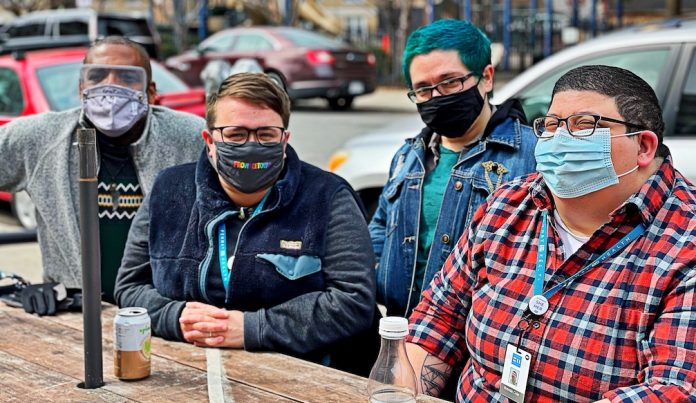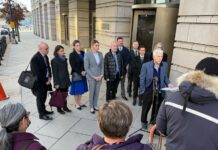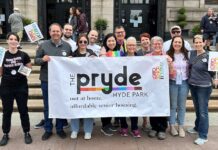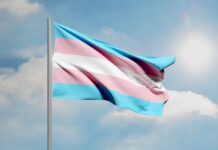To say we are living in an unprecedented time is now a cliché.
But the truth is, there is no road map for this moment in history. Few people knew what it would be like to live for over a year without seeing friends and family, or never traveling more than a few blocks from home. Yet that has been our existence since the beginning of the pandemic in March 2020. A year later, as more LGBTQ adults are getting vaccinated, everyone must find their own way of reemerging after this long isolation. The whole concept seems more like the fictional plot of Washington Irving’s classic Rip Van Winkle tale than any reality we have ever known.
How do we begin this process of reentry? Once we’re vaccinated, do we throw one big house party and invite all the people we have longed to see in person, or do we slowly bring people back into our lives a few at a time? What were the costs to our mental and physical health during this isolation? What are the risks involved in moving back into a social world? And how does our age impact these questions?
In February, Harvard released the findings from their national study on the impact of the pandemic.* The study found that the pandemic has made Americans much lonelier, and the loneliest group were young adults with the second loneliest demographic being the elderly. In March, The New York Times published “Fully Vaccinated and Time to Party: If You Are 70,” by Jennifer Steinhauer, about older Americans filling restaurants and cafés now that their generation is getting vaccinated.
But does this social resurgence also apply for older adults who are LGBTQ, and are our LGBTQ younger adults also struggling with loneliness?
I met with two groups representing both of these at-risk generations—younger LGBTQ adults and their senior counterparts—to learn about such concerns after their recent vaccinations. The aim was to see how they planned to reemerge and how they reflected on the year of isolation. Would they follow the national study that has younger adults at greater risk of loneliness and the older adults ready to race out in droves to gather with their friends for a night on the town?
In-person meet-ups
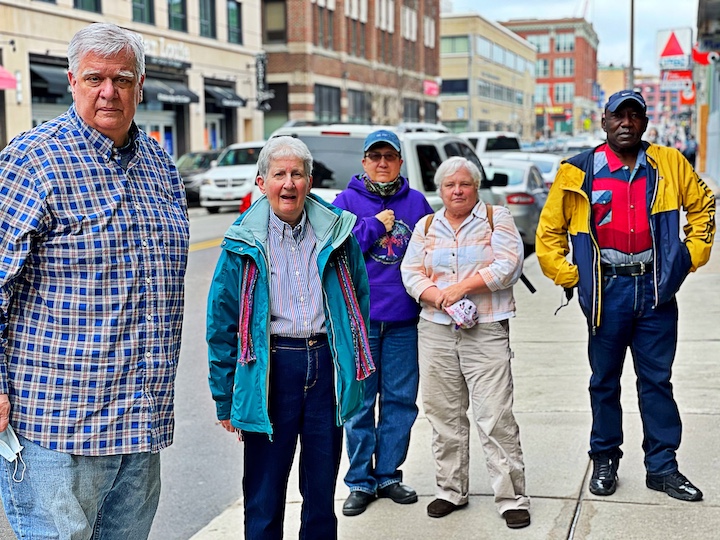
Since only adults over 60 were eligible to be vaccinated at the time, it was challenging to find the cohort of vaccinated younger adults. But following state guidelines, Fenway Health in Boston had vaccinated all their staff so they could help out with their vaccination clinic. This created a significant pool of candidates to interview.
Bren Cole, 36, from Cambridge; Jack Bruno, 31, from Somerville; Kelvin Powell 51, from Dorchester; and Dana Lyford, 34, from Watertown agreed to gather in person to discuss these questions. Even before the time came to meet, it was clear to them that something felt different. For everyone, it was the first time meeting a group of people in person outside of their own homes or “pods.” It was also the first time seeing their Fenway colleagues, who they’d seen every day before the pandemic. For Lyford, it was exciting to get out and have real plans, but then when it came time to leave, a new feeling arose. “I just didn’t want to leave home; I am so used to not going out that it felt easier to just stay put.” Powell added, “Everything becomes a new challenge. Getting on the subway, getting food, everything was about risk navigation, which leaves you feeling pretty vulnerable.” For Cole that was a big deal. “I live alone, so I can go days and days without any human contact. This is like the third time in a year I have been with this many people.”
There were different challenges gathering a group of older adults. Although it wasn’t hard to find people from this group who had been fully vaccinated, it was hard to find people willing to come out and meet in person—something most older adults have not done yet. With the guarantee that we would meet outdoors and wear masks, five brave souls stepped forward. This became complicated when it started to rain the morning of our meeting. All five leaned into their courage, and we moved indoors, masks and all, to a large conference room with open windows.
As the senior group arrived one by one, there was an energy of excitement in the air. “This is the first time I have been in a building that isn’t my own home in a year,” said Haley Thomas, 67, of Dedham. “I am excited, but I feel my blood pressure rising at being inside with people.” Maxine Schuster, 78, of Cambridge, said, “You are the first people I have seen in person other than cashiers during this whole pandemic.” Then, laughing, she added, “I’m not usually a wild person, but I needed to restrain myself when I saw all of you. I just wanted to hug everyone.” The others in the group included Angie Cerruti, 58, of Dedham; Donnell Graves, 61, from Dorchester; and Steve Honyotski, 66, of Dorchester.
Part of the excitement behind all this stemmed from the fact that these seniors spent the last year participating in a weekly online drop-in group for LGBTQ seniors hosted by The LGBT Aging Project. Before the pandemic, none of these people knew each other, and now, even though they’d never met in person prior to this, they feel deeply connected to each other.
There was a similar awkward moment with the group of younger adults when they arrived at their meeting spot at El Pelón’s outdoor café tables on Peterborough Street. After the excitement of seeing each other in person and settling into their seats came the difficult moment to remove their masks to eat and talk. This one moment, even with the knowledge that everyone was fully vaccinated, meant a new level of risk and vulnerability. Midway through our session, Bruno shared his conflicted feelings. “I feel concerned about how others are perceiving us—being together without masks may signal that we don’t care about precautions, that we are a group of ‘anti-maskers.’ They have no idea that we’ve all been vaccinated.”
The seniors had made it clear their participation was conditional on wearing masks. Thomas said, “I feel like I have had to find my voice in all this and tell people if I am going to meet anyone, I need them to agree to wear masks. I don’t want to feel peer pressure in my 60s to take risks.” Steve Honyotski said, “I have had to make some tough choices to not attend things when I know people won’t be wearing masks. I belong to a men’s group and the group just decided to return to in-person sessions, and they don’t want to wear masks, so I am not going to continue. I am also afraid I will miss Easter dinner with my family, which is a big production. They agreed to wear masks for me, but they will have to remove them at the table for Easter dinner and that terrifies me.” Each one of the seniors said they all cross the street when someone is walking on the sidewalk toward them, even if that person is wearing a mask.
Looking back on alone time
One of the most interesting differences in the groups was their reflection on the imposed isolation.
The themes for the younger adults centered on the idea that their worlds had drastically shrunk. They couldn’t maintain the level of social contact they were used to. Zoom became a thin thread that barely held some of their social connections together, but even that had its challenges. Cole shared that her social circles shrunk during this year because the only way to maintain many circles was through Zoom, and after months of being on Zoom for work and everything else, people got sick of it and stopped attending online social meetings. It was just the opposite for the seniors. Many shared that their social worlds expanded during the isolation, primarily because of the new connections made possible through Zoom. They found it exciting. They found themselves meeting new people and reconnecting with others who lived too far away for them to see on a regular basis.
Many from the younger group felt cut off from the world. They looked at it as a time of confinement. Cole felt the big excitement of her day was changing locations from her living room to the bedroom. Whereas the group of seniors found new ways to fill their time. Graves said, “I found so many ways to keep busy. I love being at home, and there was always so much to do. I was surprised because before this I was out every night and always surrounded by people. Now I am at home with my four new friends—Netflix, Hulu, Prime and HBO Max!”
The younger group buffered the feelings of isolation by spending time in pods with a few other close friends or neighbors. It seemed that a little bit of social contact counterbalanced the social isolation that marked the past year.
Regardless of age, both groups expressed different waves of loneliness and depression in the past year. Those in both groups who were single felt the isolation to a greater degree without the opportunity for human contact or touch. Powell sought out any opportunity to be outside, which included sailing and rafting over the summer with his pod.
Family played a major role for both groups. Lyford and Cole both spoke about the tremendous joy of being able to hug their fathers again after so many months apart. Honyotski said his family comes together for every holiday, and one of his darkest moments was at Christmas. “I have never missed a Christmas with my mother, and I am 66. Not to be with her this year broke my heart. Thomas has been missing her son, and now that she’s vaccinated, she looks forward to making it possible to have him come to her house.
Many people have suggested older adults weathered this pandemic better because they lived through the AIDS crisis. Graves put an end to that comparison. “Are they crazy? There is no comparison. During the AIDS crisis, I was out dancing every night. I knew what was safe and what wasn’t. I still had a life. During the coronavirus, we are cut off from the world and hiding in our homes. Everything stopped. Everything.” Honyotski added to that the only similarity was masks and condoms. “Condoms kept you safe with sexual intercourse, and masks keep you safe now with social intercourse!”
As to be expected, the older group knew more people who died from COVID-19. Graves lost a dear friend and “not being able to be with them at the end hurt my heart to the core.” But it was Bruno who suffered the greatest loss. His beloved grandmother died from COVID and he was not able to bring his partner to support him during this difficult time since his partner hasn’t been vaccinated.
Each group also reflected about their impressions of how the other generation weathered the pandemic. The younger adults were deeply concerned about their senior counterparts. Lyford shared, “If I wanted to, I could run outside to the grocery store or step out of the house to get a cup of coffee, but those things were not life-or-death risk for me. I worry how older adults faced this forced isolation. I don’t think I could have handled it.” Powell shared about watching the group he is involved with, the LGBT Elders of Color. “They love their regular Zoom drop-ins. They are chaotic and wonderful sessions. Everyone is shouting, ‘Hey, Hey’ at the same time. They are all so excited to see each other every week.” But they told him the silence was painful as soon as the meeting ended and they turned off their computer.
The seniors shared concern for younger LGBTQ adults. “We have all lived our lives and had so many wonderful experiences. I can’t imagine what they must be feeling to be missing out on these important years. “They are in the prime of their lives and it must be horrible to be missing out on these experiences,” said Graves.
Thomas spoke about the generation before her as well. “I have friends in their 70s and 80s, and I don’t want this to be how they finish out their lives.”
‘Coming back out’
There were two areas where both groups shared very similar feelings. One was the hesitancy of returning to their old ways of socializing. As many adults anticipate getting fully vaccinated, they start planning their fantasy “coming back out” event. Usually these involved large gatherings of all their friends they have missed seeing in the last year. But the younger LGBTQ adults and the seniors both felt that they were not ready to return to the full social life they had before the pandemic. Honyotski said, “I was a social butterfly, but I am not ready to run back into that life. I am just not ready.” The younger adults felt comfortable with their pods and had plans to bring in their other friends on slowly. “My days of large social events may be over. I just don’t think it will feel the same anymore,” Powell added.
The seniors felt that small cookouts this summer would be their ticket back into the social world. Cerruti shared, “We could have invited people over outside last summer, but you couldn’t have anyone inside your house, and older people need to have access to a bathroom, so we never went out at all or had anyone come over. Now we can have people over and they can use our bathroom. That’s a big step and one we’re comfortable with.”
The final area of agreement was both groups’ ability to find silver linings in this challenging time. Perhaps that comes from the resiliency that the LGBTQ community has come to be known for due to the hardships we have overcome in our history.
But regardless of the source, both younger and older adults found moments of growth and inspiration during this time of isolation. Several of the younger adults who were living with partners or spouses shared that they had to learn very quickly how to communicate in a much better way that would support this new life of living on top of each other 24 hours a day, seven days a week. The seniors said they met so many new and wonderful people through the weekly drop-in groups.
Schuster said, “Ironically I feel more connected than I have ever been before. Now I can participate more, take more online classes at Stonewall/Osher Lifelong Learning Center at UMass. Our enrollment is even up more than it has ever been.”
Honyotski said, “For me it is telemedicine. That has been such a gift. I hope that continues forever. Oh, and delivery services—what a lifesaver!”
Graves bought a car because he no longer feels safe taking public transportation.
Then, as the group was getting ready to wrap up, Graves shouted out that he forgot the most important one: “My silver lining is that I didn’t get COVID! And I am still alive.”
It doesn’t get any better than that!
* “Loneliness in America: How the Pandemic Has Deepened an Epidemic of Loneliness and What We Can Do About It,” by Richard Weissbourd, Milena Batanova, Virginia Lovison and Eric Torres
Not a subscriber? Sign up today for a free subscription to Boston Spirit magazine, New England’s premier LGBT magazine. We will send you a copy of Boston Spirit 6 times per year and we never sell/rent our subscriber information. Click HERE to sign up!


